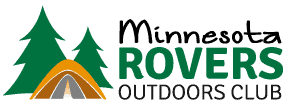Minnesota Rovers as an organization and as individual members have an interest in conservation. Partly this is because most Minnesota Rover members are environmentalists and also because Rover members want to preserve the woods, trails, rivers and lakes where they want to go for their activities. Minnesota Rover members have been involved with both the BWCA (Boundary Waters Canoe Area Wilderness) and the BRTA (Border Route Trail) since their inception.
Minnesota Rovers has ongoing conservation activies. For example:
- Trail clearing trips on the BRTA in Spring and Fall
- “Adopt a Wood Lot” Buckthorn Removal at Elm Creek Park
- Beat Back the Buckthorn at Tierney’s Woods in Bloomington
- Trail maintenance on Moss Lake Trail on edge of BWCA
- Prairie Seed Collection at Crow-Hassan Park Reserve
- Garlic Mustard Pulls at various parks
- Henry Park Cleanup in St. Paul (buckthorn & burdock)
- Snowshoe / Identify Oriental Bittersweet at Elm Creek Park in Maple Grove
Border Route Trail
The Border Route Trail (BRT) is a wilderness hiking trail that spans 65 miles along the Minnesota/Canadian Border which was built by Minnesota Rovers with help from the Minnesota DNR and the US Forest Service. It offers vistas of the wilderness lakes, cliffs, and rivers of the Boundary Waters Canoe Area Wilderness.
The BRT is a rugged trail, which can sometimes be hard to follow, but the rewards are enormous: a true wilderness experience, encounters with moose, loon and other wildlife in their natural surroundings.
The BRT connects on its eastern trailhead with the Superior Hiking Trail and on its western end (Cook Cty Rd 12, Gunflint Trail) with the Kekekabic Trail. So for an extended outing, you can hike from Two Harbors on the shores of Lake Superior to Ely, MN — a major hub for canoeists entering the Boundary Waters Canoe Area. The Border Route Trail is part of a planned major reroute to the North Country National Scenic Trail which will eventually link New York state with North Dakota.
More information can be found on the BRTA website.

